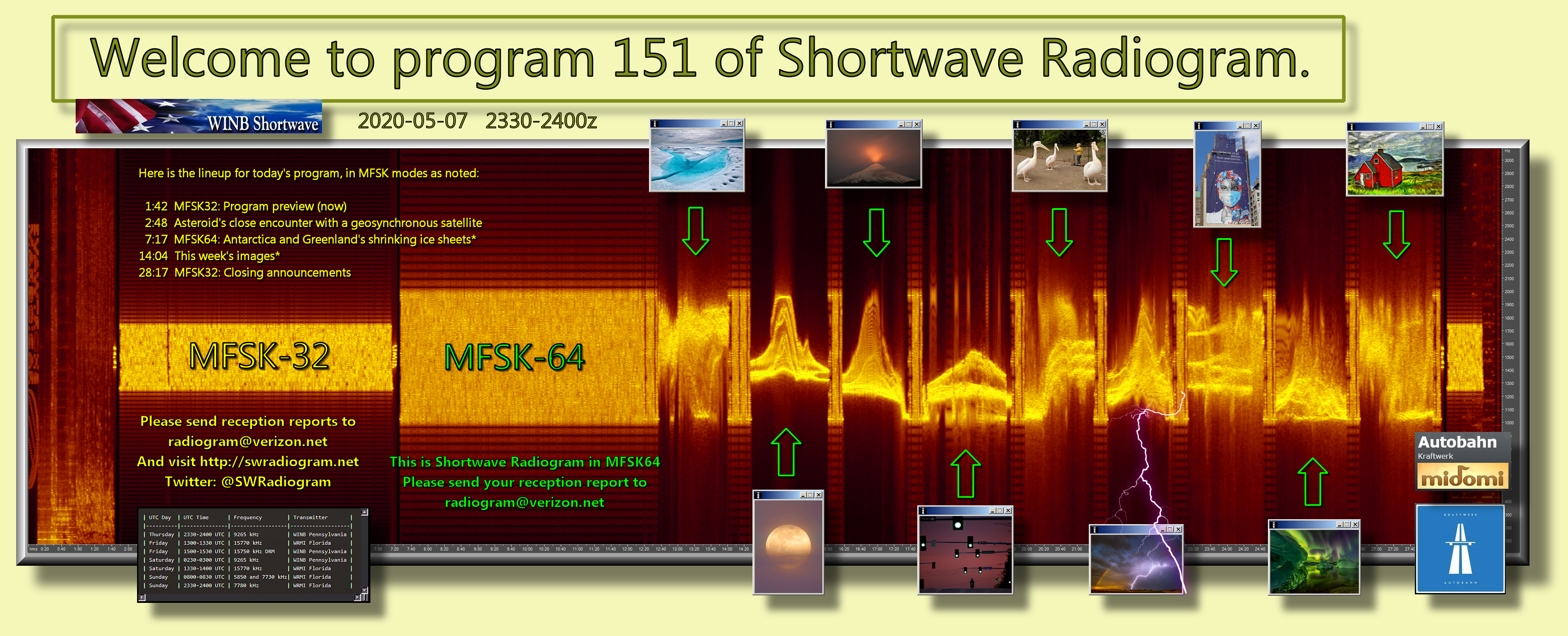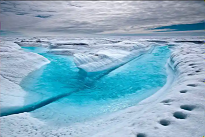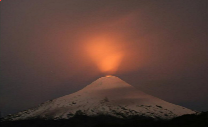http://www.rhci-online.net/radiogram/radiogram.htm
RSID: <<2020-05-10T01:30Z MFSK-64 @
http://www.rhci-online.net/radiogram/radiogram.htm
RSID: <<2020-05-10T01:30Z MFSK-64 @
9925000+1500>>
Singer-songwriter-guitarist Dave
Mason, founder of Traffic, was
born May 10, 1946.
Sending Pic:167x236;

davemasonmusic.com
Please report you decode to
themightykbc@gmail.com

RSID: <<2020-05-07T23:31Z
MFSK-32 @
9265000+1500>>
Welcome to program 151 of Shortwave Radiogram.
I'm Kim Andrew Elliott in Arlington, Virginia USA.
Here is the lineup for today's program, in MFSK modes as noted:
1:42 MFSK32: Program preview (now)
2:48 Asteroid's close encounter with a geosynchronous satellite
7:17 MFSK64: Antarctica and Greenland's shrinking ice sheets*
14:04 This week's images*
28:17 MFSK32: Closing announcements
* with image(s)
Please send reception reports to
radiogram@verizon.net
And visit http://swradiogram.net
Twitter:
@SWRadiogram
From New Atlas:
Asteroid has close encounter with geosynchronous satellite
David Szondy
1 May 2020
A small asteroid came within a cosmic hairbreadth of the ring of
communications satellites circling the Earth in geosynchronous
orbit this week. Passing by our planet at an altitude of about
35,000 km (22,000 mi), the object measuring four to eight meters
(13 to 20 ft) in diameter whizzed past the nearest satellite on
April 28, 2020, at 18:49 GMT at a distance of about 1,200 km (750
mi) on one of the closest Earth flybys ever recorded.
When we think of the danger that asteroids pose to the Earth, we
usually think of one crashing into the planet like the one that
killed off the dinosaurs 65 million years ago, but as we become
more of a spacefaring species dependent on orbital satellites,
such asteroids can potentially cause a lot of damage even if they
pass well clear of Earth.
Geosynchronous or geostationary satellites sit in an orbital band
above the equator where their orbital period is equal to the
rotation of the Earth, meaning that they always remain over the
same spot. These satellites form the backbone of the orbital
telecommunications system and mission planners go to great length
to make sure that the spacecraft don't interfere with one
another.
However, sometimes unexpected hazards can appear quite suddenly.
According to ESA, on April 26 (European time) an object was seen
by NASA's Panoramic Survey Telescope and Rapid Response System
(Pan-STARRS) in Hawaii. Originally unidentified, the object was
observed again the next night and given the temporary name of
P20Zlf8 – later changed to its current moniker of 2020 HS7.
2020 HS7 was more than another asteroid to be entered into the
books. Calculations showed that it had a 10-percent chance of
colliding with the Earth, so space scientists became immediately
interested. Less than an hour after the first report was
released, Xingming Observatory in China charted its position,
trajectory, and brightness. These observations were then refined
by the Tautenburg Observatory in Germany.
The good news was that 2020 HS7 wasn't going to collide with
Earth after all, and even if it did, it was so small that it
would burn up in the atmosphere. However, it was going to come
uncomfortably close to the geosynchronous orbital ring. The
measured 1,200 km (746 mi) from the nearest satellite may seem
like a long distance, but on a cosmic scale, it's like dodging a
bullet by the width of a hair.
ESA says that the passage of 2020 HS7d provided scientists with
an exercise in quickly and accurately tracking and characterizing
new asteroids, as well as coordinating follow-up observations for
extremely precise measurements, confirming that 2020 HS7 is one
of the 50 closest objects ever recorded to fly by the Earth.
Source: ESA
https://newatlas.com/space/asteroid-near-miss-geosynchronous-satellite/
Shortwave Radiogram now changes to MFSK64 ...
RSID: <<2020-05-07T23:37Z
MFSK-64 @
9265000+1500>>
This is Shortwave Radiogram in MFSK64
Please send your reception report to
radiogram@verizon.net
From Futurity.org:
Antarctica, Greenland losing 318 gigatons of ice a year
Posted by Hannah Hickey
5 May 2020
Loss of ice from Antarctica and Greenland's shrinking ice sheet
is responsible for 0.55 inches (14 millimeters) of sea level rise
since 2003, according to a new study.
Using the most advanced Earth-observing laser instrument NASA has
ever flown in space, researchers made precise measurements of how
the Greenland and Antarctic ice sheets have changed over 16
years.
As reported in Science, the loss of the floating ice shelves
melting in a warming ocean drives sea level rise in Antarctica.
These ice shelves help hold back the flow of land-based ice.
The findings come from the Ice, Cloud, and land Elevation
Satellite 2 (ICESat-2), which launched into orbit in fall 2018
and began taking detailed global elevation measurements,
including over Earth's frozen regions.
Comparing the new data with measurements the original ICESat took
from 2003 to 2009 allowed researchers to generate a comprehensive
portrait of the complexities of ice sheet change—and insights
into the future of Greenland and Antarctica.
"If you watch a glacier or ice sheet for a month, or a year,
you're not going to learn much about what the climate is doing to
it," says lead author Benjamin Smith, a glaciologist at the
University of Washington Applied Physics Laboratory.
"We now have a 16-year span between ICESat and ICESat-2 and can
be much more confident that the changes we're seeing in the ice
have to do with the long-term changes in the climate. And
ICESat-2 is a really remarkable tool for making these
measurements. We're seeing high-quality measurements that carpet
both ice sheets, which let us make a detailed and precise
comparison with the ICESat data."
Thinning glaciers
Previous studies of ice loss or gain often analyze data from
multiple satellites and airborne missions. The new study takes a
single type of measurement—height as measured by an instrument
that bounces laser pulses off the ice surface—providing the most
detailed and accurate picture of ice sheet change to date.
The researchers took tracks of ICESat measurements and overlaid
the denser tracks of ICESat-2 measurements from 2019. Where the
two data sets intersected—tens of millions of sites—the
researchers ran the data through computer programs that accounted
for the snow density and other factors, and then calculated the
mass of ice lost or gained.
"The new analysis reveals the ice sheets' response to changes in
climate with unprecedented detail, revealing clues as to why and
how the ice sheets are reacting the way they are," says coauthor
Alex Gardner, a glaciologist at NASA's Jet Propulsion Laboratory
in Pasadena, California.
The study shows that Greenland's ice sheet lost an average of 200
gigatons of ice per year, and Antarctica's ice sheet lost an
average of 118 gigatons of ice per year. One gigaton of ice is
enough to fill 400,000 Olympic-sized swimming pools.
Of the sea level rise that resulted from ice sheet meltwater and
iceberg calving, about two-thirds of it came Greenland, the other
third from Antarctica, Smith says.
"It was amazing to see how good the ICESat-2 data looked, right
out of the gate," says coauthor Tom Neumann from NASA's Goddard
Space Flight Center in Greenbelt, Maryland. "These first results
looking at land ice confirm the consensus from other research
groups, but they also let us look at the details of change in
individual glaciers and ice shelves at the same time."
In Greenland, there was a significant amount of thinning of
coastal glaciers, Smith says. The Kangerlussuaq and Jakobshavn
glaciers, for example, have lost 14 to 20 feet (4 to 6 meters) of
elevation per year. Warmer summer temperatures have melted ice
from the surface of the glaciers and ice sheets, and in some
places warmer ocean water erodes away the ice at their fronts.
In Antarctica, the dense tracks of ICESat-2 measurements showed
that the ice sheet is getting thicker in parts of the continent's
interior, likely as a result of increased snowfall, Smith says.
The loss of ice from the continent's margins, especially in West
Antarctica and the Antarctic Peninsula, however, far outweighs
any gains in the interior. In those places, the ocean is also
likely to blame.
"In West Antarctica, we're seeing a lot of glaciers thinning very
rapidly," Smith says. "There are ice shelves at the downstream
end of those glaciers, floating on water. And those ice shelves
are thinning, letting more ice flow out into the ocean as the
warmer water erodes the ice."
These ice shelves, which rise and fall with the tides, can be
difficult to measure, says coauthor Helen Amanda Fricker, a
glaciologist at Scripps Institution of Oceanography at the
University of California, San Diego. Some of them have rough
surfaces, with crevasses and ridges, but the precision and high
resolution of ICESat-2 allows researchers to measure overall
changes, without worrying about these features skewing the
results.
Stability from ice sheets
This is one of the first times that researchers have measured
loss of the floating ice shelves around Antarctica simultaneously
with loss of the continent's ice sheet.
Ice that melts from ice shelves doesn't raise sea levels, since
it's already floating—just like an ice cube melting in a full cup
of water doesn't overflow the glass. But the ice shelves do
provide stability for the glaciers and ice sheets behind them.
"It's like an architectural buttress that holds up a cathedral,"
Fricker says. "The ice shelves hold the ice sheet up. If you take
away the ice shelves, or even if you thin them, you're reducing
that buttressing force, so the grounded ice can flow faster."
The researchers found ice shelves in West Antarctica, the
location of many of the continent's fastest-moving glaciers, are
losing mass. Patterns of thinning show that Thwaites and Crosson
ice shelves have thinned the most, an average of about 5 meters
(16 feet) and 3 meters (10 feet) of ice per year, respectively.
NASA funded the study. Additional coauthors are from NASA;
Amherst College; the University of California, San Diego; the
University of Maryland; the University at Buffalo; the Colorado
School of Mines; and the University of Washington.
Source: University of Washington
https://www.futurity.org/ice-sheets-sea-level-antarctica-greenland-2356392-2/
Image: Each summer, streams channel much of the melt that is
produced by the warmer temperatures along lower levels of the
Greenland ice sheet. From
bit.ly/2A9mbzL ...
Sending Pic:205x137C;

This is Shortwave Radiogram in MFSK64
Please send your reception report to
radiogram@verizon.net
This week's images ...
The Flower Moon, last supermoon of 2020, rising "in a mauve haze"
at Ottawa, Ontario, 6 May. From
bit.ly/2WdfXY1 ...
Sending Pic:151x207C;
The recently re-opened Villarrica Volcano national park, Pucon,
Chile, 29 April. From
reut.rs/3fmNiHD ...
Sending Pic:208x127C;

A motorcyclist drives on an empty street as the sun sets in
downtown Topeka, Kansas, on 28 April. From
nbcnews.to/3dojVCN ...
Sending Pic:206x172C;

A group of pelicans pass a boy on a scooter in St James' Park
during the lockdown. From
bit.ly/2zi5IJ3 ...
Sending Pic:205x135C;

A lightning bolt strikes near a rainbow at Lewiston, Idaho, 29
April. From
cnn.it/2zdo9OV ...
Sending Pic:203x130C;

A mural dedicated to nurses is painted on the side of a building
on 34th Street and Eighth Avenue in Midtown Manhattan. From
bit.ly/2ysapQx ...
Sending Pic:143x212C;
Northern lights illuminating icebergs in Greenland. From
bbc.in/3cc8yxR ...
Sending Pic:198x142C;

Our painting of the week is "Little Red House in Greenland" by
Mario Carini. From
bit.ly/2WG8mAq ...
Sending Pic:210x140C;

Shortwave Radiogram returns to MFSK32 ...
RSID: <<2020-05-07T23:57Z
MFSK-32 @
9265000+1500>>
This is Shortwave Radiogram in MFSK32 ...
Shortwave Radiogram is transmitted by:
WRMI, Radio Miami International, wrmi.net
and
WINB Shortwave, winb.com
Please send reception reports to
radiogram@verizon.net
And visit http://swradiogram.net
Twitter:
@SWRadiogram or
twitter.com/swradiogram
I'm Kim Elliott. Please join us for the next Shortwave
Radiogram.
|
Ending music: https://www.midomi.com/index.php?action=main.track&track_id=100447631616611034&from=voice_search Kraftwerk - Autobahnhttps://youtu.be/e11h73WhqK4
|
http://www.rhci-online.net/radiogram/radiogram.htm
|
QTH: |
D-06193 Petersberg (Germany/Germania) |
|
|
Ant.: |
Dipol for 40m-Band & Boomerang Antenna 11m-Band |
|
|
RX for RF: |
FRG-100B + IF-mixer & ICOM IC-R75 + IF-mixer |
|
|
Software IF: |
con STUDIO1 - Software italiano per SDR [S-AM-USB/LSB] + beta 11 Version 2.80 (August 21, 2018) - for scheduled IF-recording |
|
|
Software AF: |
Fldigi-4.0.18 + flmsg-4.0.7 images-fldigifiles on homedrive.lnk |
|
|
OS: |
German XP-SP3 with support for asian languages |
German W7 32bit + 64bit |
|
PC: |
MEDION Titanium 8008 (since 2003) [ P4 - 2,6 GHz] |
MSI-CR70-2MP345W7 (since2014) [i5 -P3560 ( 2 x 2,6GHz) ] |
http://wiki.radioreference.com/index.php/Decoding_the_SW_Radiogram_Broadcasts
https://www.qsl.net/ve7vv/Files/Digital%20Modes.pdf
2020-05-03 1800-1830z 6070 kHz ch292 RNEI#04
2020-05-03 1830-1900z 6070 kHz ch292 TIAEMS-May-2020
2020-05-06 2100-2200z 7780 kHz WRMI TIAMS#063 (1st)
2020-05-07 0200-0300z 5850 kHz WRMI TIAMS#063 (2nd)
2020-05-07 2330-2400z 9265 kHz WINB SWRG#151 (1st)
2020-05-08 0930-1000z 3210 kHz Unique Radio Australia RNEI#03
2020-05-08 1000-1100z 3210 kHz Unique Radio Australia TIAMS#063 (3rd)

RSID: <<2020-05-06T21:46Z MFSK-64 @
7780000+1500>>
Sending Pic:300x300Cp4;

RSID: <<2020-05-06T21:48Z
MFSK-64 @
7780000+1500>>

This Is A Music Show #063
6 May 2020
2100-2200UTC Wednesday on 7780 kHz
0200-0300UTC Thursday on 5850 kHz
via WRMI, Okeechobee USA
Rebroadcast on Unique Radio, Australia
1000-1100UTC Friday on 5045 kHz USB
***ALSO***
TIAExpressMS w/ Radio Northern Europe International
via Channel 292 in Germany, on 6070 kHz.
Broadcast various dates/times. Check the schedule here:
https://www.channel292.de/schedule-6070-khz/
https://rnei.org/
----------------------------------------
PLAYLIST
Kraftwerk - Numbers
-----
Kraftwerk - Antenna
Heatseekers - Thingmaker
King Floyd - Groove Me
♫♥
-----
Kraftwerk - 電卓
Marc Hamilton - Tapis Magique
Future Shock - The Message
-----
Kraftwerk - Tour De France
Takeshi Terauchi and The Bunnys - Feedback Guitar
The 5 Stairsteps- Dear Prudence
-----
The Spotnicks - Old Clock At Home
-----
THIS DATA
------
Kraftwerk - Ohm Sweet Ohm
----------------------------------------
Links of note:
Kraftwerk "Radioactivity" live in Tokyo, 2002
https://youtu.be/ZWJ5733vbFA
Kraftwerk "Dentaku" also Tokyo 2002?
https://youtu.be/oAmxGglMXYg?t=180
-----
Please send reception reports/comments:
thisisamusicshow@gmail.com
Follow TIAMS on Twitter:
www.twitter.com/ThisIsAMusicSho/
------
Thanks for listening!
--YOUR HOST--
EOM
RSID: <<2020-05-06T21:50Z
MFSK-64 @
7780000+1500>>
Sending Pic:300x300p4;


<<2020-05-06T21:51Z CW Rx 18 @ 7780000+1500>>
RSID: <<2020-05-09T18:26Z MFSK-32 @ 6070000+1500>>
Thanks for listening to RNEI 4!
qsl@rnei.org.
Played today:
TIAMS has made another 30 minute express music show for after our broadcast for you to enjoy!
| Date | Time | Frequency | Target Zone |
| Sunday the 3rd of May 2020 | 18:00 UTC | 6070KHz | Zone 1+2 |
| Saturday the 9th of May 2020 | 18:00 UTC | 6070KHz | Zone 1+2 |
| Friday the 15th of May 2020 | 10:00 UTC | 6070KHz | Zone 1 |
| Saturday the 23rd of May 2020 | 00:00 UTC | 6070KHz | Zone 2+ |
| Sunday the 31st of May 2020 | 18:00 UTC | 6070KHz | Zone 1+2 |